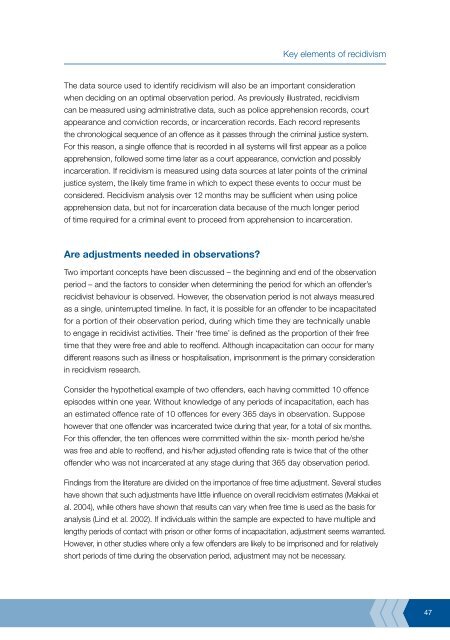Recidivism in Australia : findings and future research - Australian ...
Recidivism in Australia : findings and future research - Australian ...
Recidivism in Australia : findings and future research - Australian ...
You also want an ePaper? Increase the reach of your titles
YUMPU automatically turns print PDFs into web optimized ePapers that Google loves.
The data source used to identify recidivism will also be an important consideration<br />
when decid<strong>in</strong>g on an optimal observation period. As previously illustrated, recidivism<br />
can be measured us<strong>in</strong>g adm<strong>in</strong>istrative data, such as police apprehension records, court<br />
appearance <strong>and</strong> conviction records, or <strong>in</strong>carceration records. Each record represents<br />
the chronological sequence of an offence as it passes through the crim<strong>in</strong>al justice system.<br />
For this reason, a s<strong>in</strong>gle offence that is recorded <strong>in</strong> all systems will first appear as a police<br />
apprehension, followed some time later as a court appearance, conviction <strong>and</strong> possibly<br />
<strong>in</strong>carceration. If recidivism is measured us<strong>in</strong>g data sources at later po<strong>in</strong>ts of the crim<strong>in</strong>al<br />
justice system, the likely time frame <strong>in</strong> which to expect these events to occur must be<br />
considered. <strong>Recidivism</strong> analysis over 12 months may be sufficient when us<strong>in</strong>g police<br />
apprehension data, but not for <strong>in</strong>carceration data because of the much longer period<br />
of time required for a crim<strong>in</strong>al event to proceed from apprehension to <strong>in</strong>carceration.<br />
Are adjustments needed <strong>in</strong> observations?<br />
Key elements of recidivism<br />
Two important concepts have been discussed – the beg<strong>in</strong>n<strong>in</strong>g <strong>and</strong> end of the observation<br />
period – <strong>and</strong> the factors to consider when determ<strong>in</strong><strong>in</strong>g the period for which an offender’s<br />
recidivist behaviour is observed. However, the observation period is not always measured<br />
as a s<strong>in</strong>gle, un<strong>in</strong>terrupted timel<strong>in</strong>e. In fact, it is possible for an offender to be <strong>in</strong>capacitated<br />
for a portion of their observation period, dur<strong>in</strong>g which time they are technically unable<br />
to engage <strong>in</strong> recidivist activities. Their ‘free time’ is def<strong>in</strong>ed as the proportion of their free<br />
time that they were free <strong>and</strong> able to reoffend. Although <strong>in</strong>capacitation can occur for many<br />
different reasons such as illness or hospitalisation, imprisonment is the primary consideration<br />
<strong>in</strong> recidivism <strong>research</strong>.<br />
Consider the hypothetical example of two offenders, each hav<strong>in</strong>g committed 10 offence<br />
episodes with<strong>in</strong> one year. Without knowledge of any periods of <strong>in</strong>capacitation, each has<br />
an estimated offence rate of 10 offences for every 365 days <strong>in</strong> observation. Suppose<br />
however that one offender was <strong>in</strong>carcerated twice dur<strong>in</strong>g that year, for a total of six months.<br />
For this offender, the ten offences were committed with<strong>in</strong> the six- month period he/she<br />
was free <strong>and</strong> able to reoffend, <strong>and</strong> his/her adjusted offend<strong>in</strong>g rate is twice that of the other<br />
offender who was not <strong>in</strong>carcerated at any stage dur<strong>in</strong>g that 365 day observation period.<br />
F<strong>in</strong>d<strong>in</strong>gs from the literature are divided on the importance of free time adjustment. Several studies<br />
have shown that such adjustments have little <strong>in</strong>fluence on overall recidivism estimates (Makkai et<br />
al. 2004), while others have shown that results can vary when free time is used as the basis for<br />
analysis (L<strong>in</strong>d et al. 2002). If <strong>in</strong>dividuals with<strong>in</strong> the sample are expected to have multiple <strong>and</strong><br />
lengthy periods of contact with prison or other forms of <strong>in</strong>capacitation, adjustment seems warranted.<br />
However, <strong>in</strong> other studies where only a few offenders are likely to be imprisoned <strong>and</strong> for relatively<br />
short periods of time dur<strong>in</strong>g the observation period, adjustment may not be necessary.<br />
47















